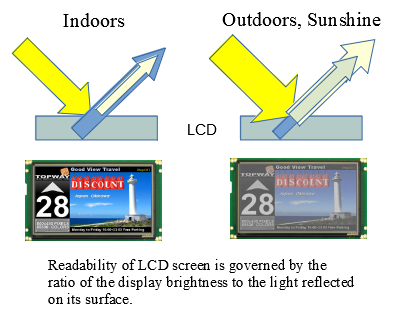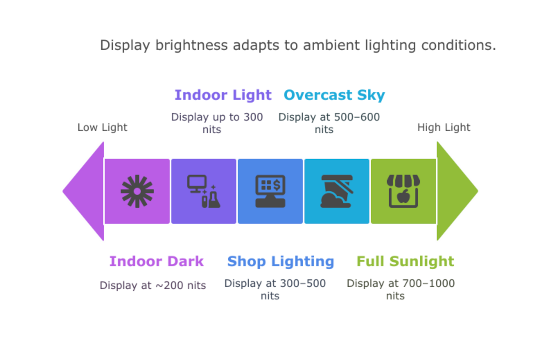High Brightness TFT LCDs: Achieving Optimal Visibility in Any Light
Standard TFT LCD displays are perfectly suitable for indoor environments with controlled lighting. However, when a display needs to perform outdoors in direct sunlight, in bright retail spaces, or in industrial settings exposed to intense illumination, a standard LCD simply won't cut it. The image washes out, becoming difficult or impossible to read. This is where high brightness TFT LCDs become essential.

What Defines a High Brightness TFT LCD?
Brightness, or luminance, is measured in nits (cd/m² - candela per square meter). A typical laptop or home appliance might offer brightness levels between 200 and 300 nits. Standard industrial or embedded LCDs often range from 300 to 500 nits.

A display is generally considered "high brightness" when its luminance exceeds 500 nits, often ranging from 700 nits up to 1500 nits or even higher. This significantly increased output is the key to making the display readable under bright ambient light conditions, including direct sunlight. This is why they are often referred to as sunlight readable LCDs.
How is High Brightness Achieved?
Achieving such high luminance requires significant engineering within the display's backlight unit. This typically involves:
- More Powerful LED Backlights: Utilizing brighter, more numerous, or more efficient LED light sources compared to standard displays.
- Optimized Light Guides and Diffusers: Designing these components to maximize light transmission and uniformity across the display area.
- Enhanced Optical Films: Employing specialized films that boost brightness and improve light management.
- Efficient Thermal Management: More powerful backlights generate heat, so effective heat dissipation is crucial to maintain performance and lifespan.
Here is a more comprehensive discussion on sunlight readable LCD.
Key Benefits of High Brightness TFT LCDs
Sunlight Readability: The primary advantage. Ensures displays remain clear and readable even in direct sunlight or intensely lit environments.
Improved Contrast in Bright Conditions: While high brightness is key, a good contrast ratio is also vital, and the increased luminance helps maintain perceived contrast in bright ambient light.
Enhanced Visual Clarity: Text, graphics, and images are sharp and vibrant, even under challenging lighting.
Robust Performance: Often designed with components capable of handling higher temperatures generated by the powerful backlight.
Typical Applications
The need for visibility in bright conditions makes high brightness TFT LCDs indispensable for a wide range of applications:
Industrial Equipment: HMIs (Human-Machine Interfaces), control panels on machinery used in brightly lit factories or outdoor sites.
Medical Devices: Portable medical equipment used in varying lighting conditions, such as wards and ER.
Outdoor Kiosks & Digital Signage: Information displays, advertising boards, ticketing machines used outdoors.
Automotive: Infotainment systems, dashboard displays (especially in convertibles or open vehicles).
Marine Displays: GPS navigators, sonar displays, control panels exposed to sun and glare on boats.
Point-of-Sale (POS) Systems: Outdoor or brightly lit retail environments.
Avionics: Cockpit displays where sunlight readability is critical.
Choosing the Right High Brightness Display
When selecting a high brightness TFT LCD, we should consider not only the nits rating, but also:
Contrast Ratio: How well the display differentiates between light and dark areas in bright light. For low-end displays the contrast value range is 300 to 500 and for high-end ones it can go as high as 1000 to 2000.
Operating Temperature Range: Essential for outdoor or industrial use. Topway's TFT LCDs usually have the range of -20°C ~ 70°C.
Viewing Angles: Ensures readability from various positions.
Power Consumption: High brightness requires more power.
Lifespan of the Backlight: Measured in hours (e.g., 50,000 hours).
Anti-Glare or Anti-Reflective Coatings: Further improves outdoor visibility by reducing reflections.
Conclusion
In summary, high brightness TFT LCDs are a crucial technology for applications demanding display visibility under challenging, brightly lit conditions. By delivering significantly higher luminance than standard displays, they ensure that critical information remains clear, readable, and effective, whether in direct sunlight or intense indoor lighting.
Topway High Brightness TFT LCD
Topway's high brightness TFT displays ensure your content remains vibrant and clear even under the brightest conditions, providing your customer an exceptional viewing experience.
| Size (inch) | Model | Resolution | Brightness (nits) | Interface | Touchscreen |
|---|---|---|---|---|---|
| 2.8 | LMT028FNHFWA-NAN | 320x240 | 1000 | MCU | NO |
| 3.5 | LMT035FNAFSA | 320x240 | 1000 | RGB | NO |
| 5 | LMT050DNCFWU-3 | 800x480 | 1100 | RGB | NO |
| 5 | LMT050ENCFWU | 800X480 | 1000 | RGB | NO |
| 7 | LMT070DICFWD-AKE | 800X480 | 900 | LVDS | CTP |
| 7 | LMT070DDCFWD-6 | 800x480 | 700 | RGB | NO |
| 7 | LMT070DICFWD-NLD | 800X480 | 700 | LVDS | CTP |
| 7 | LMT070DNCFWD-6 | 800X480 | 700 | RGB | NO |
| 7 | LMT070FNMFWA-NND-1 | 1024X600 | 800 | LVDS | CTP |
| 8 | LMT080DNEFWU-ABD | 800X600 | 700 | LVDS | CTP |
| 10.1 | LMT101DNLFWD-AAD | 1280x800 | 850 | HDMI | CTP |
| 10.1 | LMT101DNLFWD-BAD | 1280X800 | 850 | LVDS | CTP |
| 10.1 | LMT101DNLFWD-NND | 1280X800 | 850 | LVDS | CTP |
| 10.1 | LMT101DNLFWD-NND-1 | 1280x800 | 850 | LVDS | CTP |
